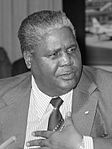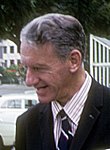Zimbabwean parliamentary election, 1980
|
|
|||||||||||||||||||||||||||||||||||||||||||||||||||||
|
|||||||||||||||||||||||||||||||||||||||||||||||||||||
|
All 100 seats in the House of Assembly |
|||||||||||||||||||||||||||||||||||||||||||||||||||||
|---|---|---|---|---|---|---|---|---|---|---|---|---|---|---|---|---|---|---|---|---|---|---|---|---|---|---|---|---|---|---|---|---|---|---|---|---|---|---|---|---|---|---|---|---|---|---|---|---|---|---|---|---|---|
|
|||||||||||||||||||||||||||||||||||||||||||||||||||||
|
|||||||||||||||||||||||||||||||||||||||||||||||||||||
General elections were held in Southern Rhodesia in February 1980 to elect a government which would govern the country after it was granted independence as Zimbabwe, in accordance with the conclusions of the Lancaster House Agreement. The result was a victory for ZANU, which won 57 of the 100 seats. Its leader, Robert Mugabe became the first Prime Minister of Zimbabwe when the country officially became independent from the United Kingdom in April.
Agreement at Lancaster House on the fundamentals of the constitution was relatively easy. The new House of Assembly was to comprise 100 members, of whom 80 would be elected on a common roll by every adult citizen. The intention was to move to election in single member constituencies but owing to the lack of an electoral roll and the timescale, the first election was to be conducted by provinces using closed lists put forward by the political parties. Voters had their fingers marked with an invisible ink that showed up under Ultraviolet light to detect attempts to vote twice. To qualify for seats in a province, a party needed to achieve a threshold of 10% of the vote, and then the seats among the eligible parties were divided proportionately.
The remaining 20 members of the House of Assembly were to be elected by the 'white roll' comprising those people (mostly white) who had previously qualified to vote. This election was conducted in 20 single member constituencies which had been drawn up by a Delimitation Commission in 1978 and were the same as those used in the 1979 'internal settlement' election. Voters who were registered on the white roll were ineligible to participate in the common roll election.
Following the passage in Zimbabwe Rhodesia of the Constitution of Zimbabwe Rhodesia (Amendment) No. 4 Act 1979 on 11 December 1979, and the arrival of Lord Soames as Governor the next day, the fourteen year U.D.I. rebellion came to an end and the colony of Southern Rhodesia returned to legality under British law. The United Kingdom Parliament then passed the Zimbabwe Act to put in place the country's independence constitution. On 21 December 1979, the formal agreement to a ceasefire in the Rhodesian Bush War (or second Chimurenga) was signed; Lord Soames also signed proclamations lifting the ban on ZANU-PF and the Zimbabwe African People's Union and granting a general amnesty to all those who had taken up arms in the war. British Army forces then set up 16 assembly points throughout Southern Rhodesia where Patriotic Front guerillas could disarm and return to civilian life; 18,300 did so by the deadline of 6 January.
...
Wikipedia




